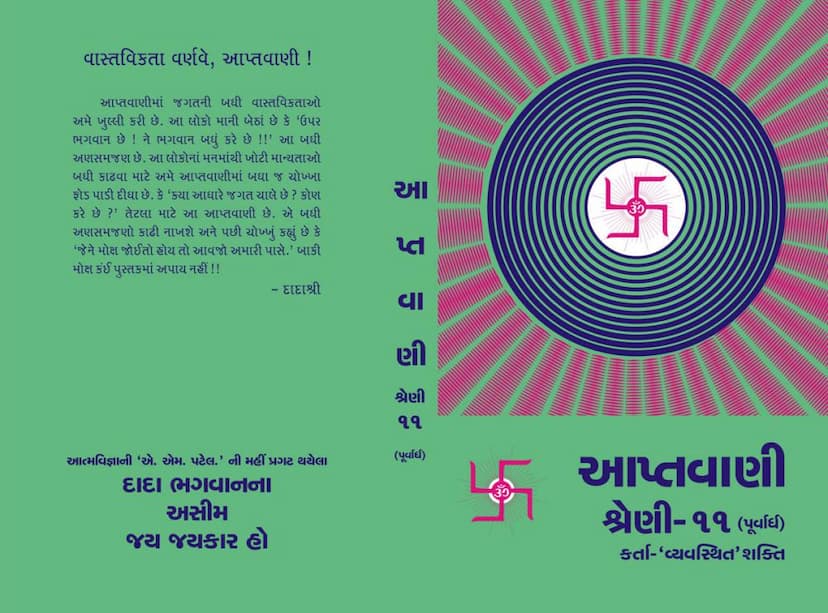Aptavani 11 P
Added to library: September 1, 2025

Summary
This is a comprehensive summary of the Jain text "Aptavani 11 P" by Dada Bhagwan, based on the provided table of contents and snippets:
Overall Theme:
The central theme of "Aptavani 11 P" is the nature of action, doership, and the functioning of the universe, as explained by Dada Bhagwan. It aims to dismantle the common misconceptions that God is the creator and controller of everything, and that humans are the doers of their actions. Instead, it posits a scientific and systematic explanation of how the world operates through the concept of "Vyavasthit Shakti" (Systematic/Scientific Circumstantial Evidence).
Key Concepts Explained:
-
Who is the Doer? (कर्ता को?):
- The text strongly refutes the idea of an external God who controls everything. It clarifies that "God" is not a creator or controller in the traditional sense.
- It emphasizes that no individual is truly independent in their actions; all actions are governed by "Vyavasthit Shakti" or "Scientific Circumstantial Evidences."
- Humans are considered "Naimittik Karta" (instrumental doers) rather than independent doers. The real doer is the "Vyavasthit Shakti."
- The misconception of "I am the doer" (હું કર્તા છું) is identified as the root cause of suffering and karma bondage.
-
Vyavasthit Shakti (વ્યવસ્થિત શક્તિ):
- This is the core concept, explained as the scientific, circumstantial, and systematic force that governs the entire universe. It's not a divine being or a deity, but rather the intricate web of causes and conditions that lead to specific results.
- "Vyavasthit" is described as an exact science, a complete puzzle in itself. It operates without any external controller, including God.
- It is compared to a computer system where actions are programmed (feed) and results are produced (output).
- "Vyavasthit" is responsible for the creation, sustenance, and dissolution of things, operating impersonally and scientifically. It is a force beyond the understanding of ordinary intellect.
-
Karma and its Liberation:
- Karma bondage is seen as a consequence of the mistaken belief of being the doer.
- True liberation (Moksha) comes from realizing the Self and understanding the workings of "Vyavasthit."
- The text differentiates between "Prarabdha" (destined karma) and "Purushartha" (self-effort). It suggests that understanding "Vyavasthit" helps in navigating these without attachment.
- The concept of "Akram Vigyan" (non-sequential science) is presented as a shortcut to Self-realization and freedom from karma.
-
The Nature of Reality:
- The universe is described as a "puzzle itself," governed by scientific laws and circumstantial evidence, not by the will of a personal God.
- The Self (Aatma) is pure consciousness, knowledge, and bliss, and is distinct from the physical body and the mind.
- The text differentiates between the real Self (Aatma) and the relative self (Ahamkar, mind, ego).
-
Rejection of Traditional Religious Beliefs:
- The text challenges conventional beliefs about a God who intervenes, rewards, or punishes.
- It states that God (as understood in traditional religions) is not the creator or sustainer. True God resides within as the pure Self.
- It critiques the ritualistic and devotional practices that don't lead to true self-understanding.
-
Practical Application:
- The core message is to shed the ego and the belief of being the doer.
- By understanding "Vyavasthit," one can attain equanimity and freedom from worry and suffering.
- The teachings emphasize direct experience and realization of the Self through the "Akram Vigyan" path, facilitated by a Gnani Purush (Self-realized being).
Structure of the Book (as per Table of Contents):
The book is divided into sections that systematically explore these concepts:
- Who is the Doer? How much is our doership? (कर्त्ता कौन ? हमारा कर्त्तापनुं केटluं ?) - Addresses the fundamental question of agency.
- Vyavasthit Shakti: Scientific Circumstantial Evidences of the World! (વ્યવસ્થિત શક્તિ: સાયન્ટિફિક સરકમસ્ટેન્શિયલ એવિડન્સા ધી વર્લ્ડ ઈઝ ધી પઝલ ઈટસેલ્ફ !) - Explains the core concept of the universe's functioning.
- Prarabdha-Purushartha and Karma Fruits: (પ્રારબ્ધ-પુરુષાર્થ અને કર્મ ફળો) - Discusses destiny and self-effort in light of karma.
- The Result of Avsthit: Vyavasthit! (અવસ્થિતતું પરિણામ વ્યવસ્થિત !) - Explains how actions lead to results within the system.
- Creation-Dissolution in Self-Power: (સર્જન-વિસર્જન સ્વસત્તામાં) - Touches upon the creation and dissolution processes.
- The Beginning of Vyavasthit! (આદિ વ્યવસ્થિતની !) - Explores the origin and nature of this force.
- Aatma - Doer from the transactional perspective, Instrumental Doer: (આત્મા-વ્યવહારથી કર્તા-નૈમિત્તિક કર્તા) - Differentiates between the real and transactional self.
- Ordered Stages of Substances: (ક્રમબદ્ધ પર્યાય વસ્તુના પર્યાયો ક્રમબદ્ધ પણે) - Discusses the sequential nature of events and existence.
- Five Samavaya Causes - Niyativada... (પાંચ સમવાય કારણો - નિયતિ...) - Examines the interplay of various factors leading to an event, with "Niyati" (destiny) being a key element.
- Dravya-Kshetra-Kaal-Bhav: (દ્રવ્ય-ક્ષેત્ર-કાળ-ભાવ) - Explores the spatio-temporal and circumstantial aspects of existence.
- The Knower acts, yet desires, so be it! (જ્ઞાતી કરે, છતાં ચાહે સો કરે !) - Discusses the role of knowledge and desire in action.
Author's Perspective (Dada Bhagwan):
Dada Bhagwan, also known as A. M. Patel, is presented as a fully liberated soul (Param Vitraag Purush) who attained complete self-realization and a profound understanding of the universe's mechanics in just one hour. His teachings are characterized by their scientific approach and simplicity, aiming to remove the ignorance and misconceptions prevalent in society. The "Aptavani" series is a collection of his spoken words, transcribed and compiled for the benefit of seekers.
In essence, "Aptavani 11 P" offers a radical reinterpretation of causality, doership, and the ultimate reality, guiding the reader towards self-realization by dismantling the illusion of the ego as the doer and revealing the impersonal, scientific workings of the universe through "Vyavasthit Shakti."